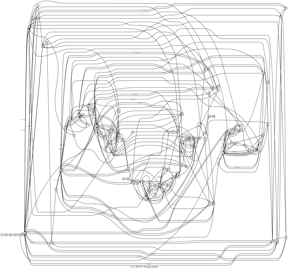Concepts
Overall Shape
Linear vs. Branching
Some works have lots of choices at almost every turn – they are more game-like. Others involve long series of passages with few or occassional choices – they are more novel-like.
“Wide” vs. “Tall”: With a left-to-right graph flow, linear-heavy works will have very wide graphs, while branch-heavy works will be very tall.
Linear-heavy (wide)
Branch-heavy (tall)
“Arboreal,” or tree-like – most of the nodes are choices, and there are many choices, generally leading to many endings.
Hierarchical vs. Web
(Arboreal vs Rhizomatic – fern-like vs. stringy, spaghetti-looking)
Many works (whether the branch or are linear) tend to proceed in order – shallow pages are reached first, deep pages are reached later. The train may switch tracks, but all the rails are running in the same direction. Such story networks tend to produce branching tree structures with perhaps a few extra edges jumping across and between them.
Other works are more web-like. For example they may be organized narratively not around the passage of time, but around movement through a series of interconnected spaces which can be visited in any order.
When web-like story networks are laid out heirarchically they tend to produce large quantities of loops that move around the main network in every direction. Sometimes taking such networks into yEd and laying them out with another algorithm (e.g. Organic or Radial) can better reveal how the story network works.
(See Exploring section for Yed representation below)
Local Features
Branch Nodes and Merge Nodes
branch node – the elevator (7 buttons). Graph vocab: “outdegree”
Merge nodes – a local funnel (see also convergent endings) Graph vocab: “indegree”
Branch-merge – Very high degree node. See log for “interesting” nodes listed from any given graph, they will be branches or merges.
Computing Fake Nodes
Interactive Nodes
False Endings
Reference Page
Shortcuts and Loopbacks
(Long arrows jumping forward or back)
…
Shortcuts
(Long forward arrows)
Most noticible in linear works. Multiple shortcuts create an optimal shortest path to the end – the work may have a story 50 lexias deep, but one can reach the finish by only reading 6 lexias. (see log: “diameter”)
Loopbacks
(Long reverse arrows)
- starting over
- it was all a dream
- try again, this time as the wizard?
For the first example, see node 4. For the second example, see node sequence 88->18->1.
Convergent Endings
Some convergent ending patterns funnel together many “lose” endings, leaving a separate “win” ending.
Other stories only have a single end, often a scoring system or total assessment – or a public service announcement / moral message.
Choice Ordering
Ordered vs. Disordered Choices
Second Choice always moves the reader further into the narrative
Fragments and Floating Nodes
(disconnected parts of the graph)
“Orphans”
What’s the difference between these two graphs?
Approaches to analysis
Identical Graphs
Almost Identical Graphs
Comparative examples
CYOA (The Cave of Time)
CYOA (Abominable Snowman)
CYOA (Vampire Express)
CYOA (Inside UFO 54-40)
Node 117 choices are flipped
Dream Trips
EFT (Tenopia Island)
Inspecting and Exploring
Exploring
Inspecting







.txt.gv.png)
.txt.gv.png)
.txt.gv.png)
.txt.gv.png)
.txt.gv.png)
 --labeled.txt.gv.png)

 remediates computer functions.txt.gv.png)
















.txt.gv.png)
 one ending.txt.gv.png)


.txt.gv.png)
.txt.gv.png)

.txt.gv.png)
.txt.gv.png)
.txt.gv.png)










.txt.gv.png)
.txt.gv.png)
.txt.gv.png)
.txt.gv.png)
.txt.gv.png)

.txt.gv.png)
.txt.gv.png)
.txt.gv.png)


.txt.gv.png)
.txt.gv.png)
.txt.gv.png)
.png)